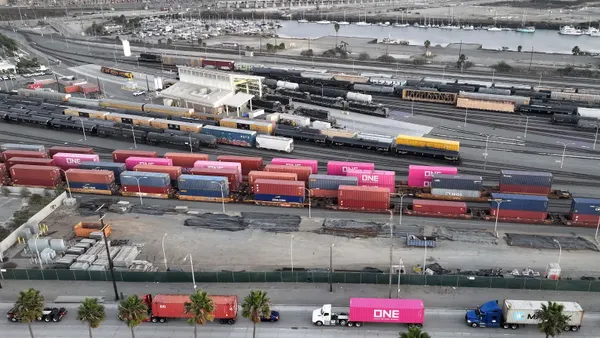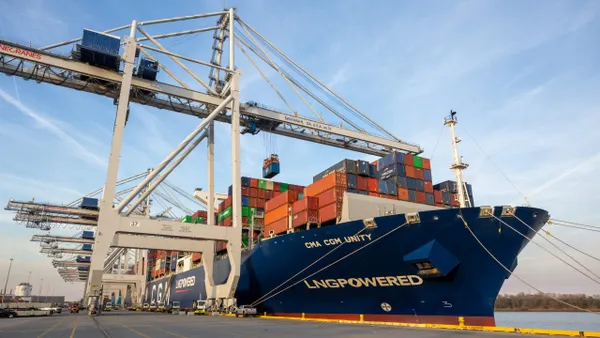Equipment shortages at U.S. ports and high container leasing prices are plaguing supply chains, as consumer spending shifts from services to goods and imports surge.
Multiple ports across the country reported record volume in September. U.S. ocean imports increased 15% YoY last month, according to Panjiva.
"This amount of cargo volume creates some supply chain complexities that must be dealt with on a daily basis," Port of Los Angeles Executive Director Gene Seroka said at a Wednesday press conference.
Loaded imports were up more than 17% YoY at the Port of Los Angeles for September, and the month closed out the strongest quarter ever for the port, according to numbers presented by the port Wednesday. But this was not enough to offset dramatic declines in the earlier months of 2020, and year-to-date import volume through September is down more than 5% YoY.
The large number of containers landing at U.S. ports has increased container availability at these facilities, but supply has plunged in Asia according to Container xChange.
As a result, container rental and lease prices are soaring in Asia.
"Traditionally [container rental and lease prices] are between 100-250 USD per container, whereas we see more and more deals for 750-1000 USD these days," a spokesperson for Container xChange said in an email.
The good news is empty containers are already on their way back to Asia. The Port of Los Angeles sent 281,000 empty containers to Asia in September, which is more than double the number of loaded exports from the port that month, according to Seroka.
The bad news is it takes weeks to get containers back and that time has not yet lapsed, according to Container xChange.
The uptick in cargo at U.S. ports has also led to a number of issues from chassis availability to increased turn time.
C.H. Robinson warned shippers Wednesday of a shortage of trucks, chassis and drivers at the Los Angeles, Long Beach and New York/New Jersey port facilities. As a result, drayage carriers have implemented a congestion surcharge, the carrier said.
"What the industry hoped would be a short-term challenge is now forecasted to last longer than expected," C.H. Robinson wrote in its customer advisory. "Due to this situation that is beyond our control, C.H. Robinson will be passing through the inland congestion charge received from our drayage providers accordingly."
The charge means shippers importing via West Coast ports could face fees and increased prices on both sides of the Pacific.
Supply chains "are working overtime" to manage increased imports and demand, National Retail Federation Vice President for Supply Chain and Customs Policy Jonathan Gold said in a statement. Imports of consumer discretionary products, including electronics, furnishings, appliances, leisure products and apparel/textile, grew 23% YoY during September, according to numbers from Panjiva.
"Nothing about this year is predictable, but retailers are making sure their shelves and warehouses are well-stocked for the holidays," Gold said. "They are also stocking up earlier than usual because they know many consumers will be shopping early this year to avoid crowds and shipping delays."













